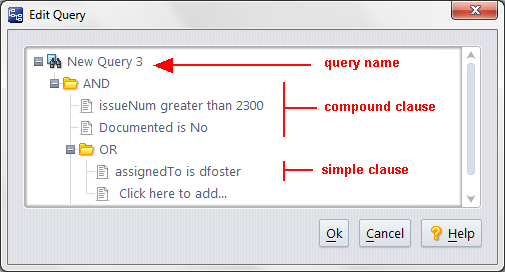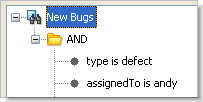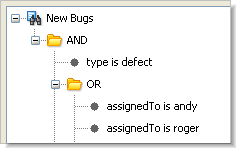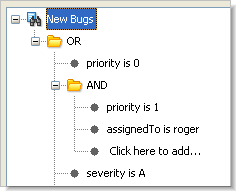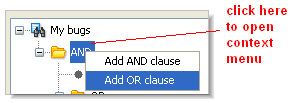|
•
|
In a Queries tab, click the
|
|
•
|
In the Change Packages subtab of the Schema Editor, click the
|
|
•
|
|
•
|
|
•
|
The context menu of a query's name in the Query Editor includes the option In English, which produces a sentence like the one above.
When you click the  New Query button to create an empty query, AccuWork assigns it a placeholder name ("New Query nnn"). You can edit the name now: click the name once to select it, then press function key F2 (or click it a second time) to begin editing it. Don't double-click — that's equivalent to using the expand/collapse control.
New Query button to create an empty query, AccuWork assigns it a placeholder name ("New Query nnn"). You can edit the name now: click the name once to select it, then press function key F2 (or click it a second time) to begin editing it. Don't double-click — that's equivalent to using the expand/collapse control.
Every query consists at least one simple clause . A simple clause has three parts:
First, you must select the <field-name> part of the clause from the list-box containing all the field-names. When you select a field-name, the query editor automatically adjusts the <comparison-operator> and <value> parts of the clause, based on the selected field. In the example below, the user has selected field-name productType, whose value must be one of these names: ColorStar, Mixer, Publisher.
The table below shows all the AccuWork data types, along with the corresponding choices for the <comparison-operator> and <value> parts of a simple clause. As you "fill in the blanks" to create simple clauses, you'll notice that AccuWork allocates new "Click here to add ..." placeholders, so that one is always available at each level of the query.
|
The comparison is always a case-insensitive string comparison, never a numeric comparison. For example, the value 3 is greater than the value 25.
The contains and does not contain operators perform a simple substring search (case-insensitive), with no pattern matching.
The matches and does not match operators perform pattern matching (case-insensitive), using these wildcards:
* matches 0 or more characters
? matches any 1 character [aekz] matches a, e, k, or z [a-e] matches a, b, c, d, or e (Note: Don’t mix uppercase and lowercase; neither [E–k] nor [e–K] matches any character] {one,two,seven} matches one, two, or seven \ or / Matches any directory-separator character, even if it’s the "wrong one" for the client machine. For example, src/do_*.java matches src\do_something.java on a Windows client. |
||
|
Note: An XML-format dump of the issue record created by Export reports the value as a number of minutes (e.g. 450).
|
||
|
Any character string. This string is compared to the Name of each of an issue record's attachments. See .
|
||
|
An integer, identifying a particular AccuWork issue record ( issueNum field) or a particular AccuRev transaction ( transNum field).
|
A compound clause combines any number of subclauses together, using the same logical operator: AND or OR. (The NOT operator is not supported.) The subclauses to be combined can, themselves, be either simple or compound.
A compound clause can contain a single subclause. This is logically equivalent to using the subclause by itself. In fact, the standard "one-line" query contain an AND clause with one simple subclause.

|
•
|
|
•
|
To change any AND clause to an OR clause (or vice-versa), select the operator and press function key F2 (or click it a second time). This opens a listbox with the values AND and OR.
|
The query name's context menu includes the option In English, which renders the query in everyday language, displaying the results in a separate window.
Whether you're composing a new query or revising an existing one, you end by saving your work (Ok button) or discarding it (Cancel button). If you didn't cancel the Query Editor session, AccuWork automatically executes the query and displays the results in the Query Results pane. Note: Closing the window using its title bar controls is equivalent to Cancel.
